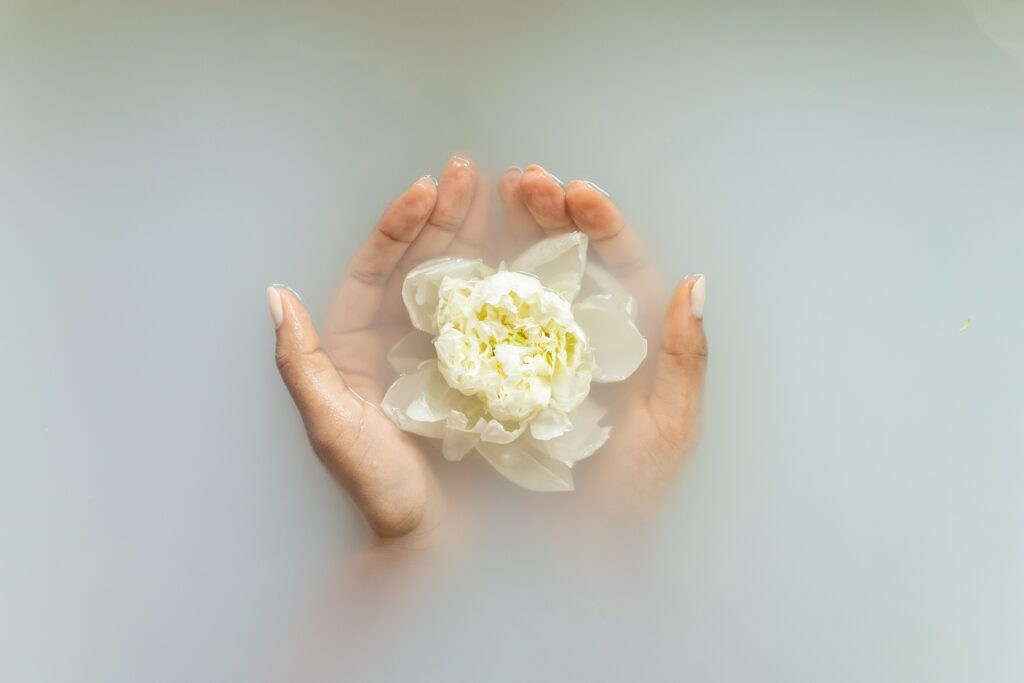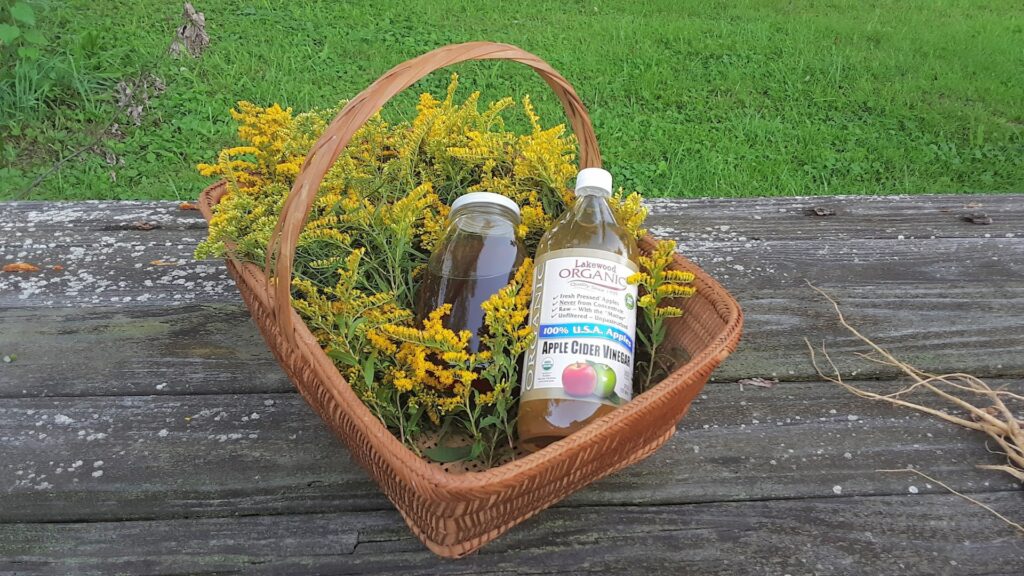Table of Contents
Hello, gorgeous readers! I’m thrilled to have you back on my blog, your ultimate beauty and wellness sanctum. Today, we’re delving into a unique topic that may have you rethinking your usual bath routine. Yes, you’ve read it right: Vinegar Baths. But don’t scrunch up your nose just yet! By the end of this post, I promise you’ll be running to your pantry to pick out one of these natural wonders – White Vinegar or Apple Cider Vinegar. So, which one comes out on top in the beauty battle of the vinegar? Let’s dive in!

Vinegar has earned a reputation as a household and culinary staple throughout the ages. But did you know that it’s also a stealthy skin savior? It’s like that underappreciated friend we all have, quietly valuable but often overlooked. In this blog post, we’ll highlight the surprising beauty benefits of white vinegar and apple cider vinegar, discussing their individual properties, unique advantages, and potential downsides.
This deep dive will educate you on how this vinegar interacts with your skin, which might suit your particular skin needs better, and how to incorporate them into your bathing routine for optimum benefits. With science-backed facts and firsthand experiences, we’ll explore this seemingly peculiar yet intriguing beauty practice.
By the end of this post, you can confidently say whether white vinegar or apple cider vinegar deserves the coveted space on the rim of your bathtub. Whether you’re a beauty guru, a skincare rookie, or a curious mind, buckle up! This will be a refreshing and informative journey into vinegar baths. So, hold tight to your loofahs, and let’s dive headfirst into the bubbly waters of vinegar-infused baths!
Say Hello to White Vinegar

The world of vinegar is vast, but white vinegar holds a special place due to its ubiquity. Derived from distilled grain alcohol, it shimmers clear and boasts a piquant aroma that might remind you of culinary adventures.
Now, let me let you in on a little secret. I recently had a mini-disaster in my kitchen with some enthusiastic baking and spilled berry jam. What was my lifesaver? That’s right, our unassuming friend – white vinegar! Its main component, acetic acid (with an acidity level ranging from 4% to 7%), swooped in to break down the stubborn grime, leaving my countertops sparkling.
But here’s a pro tip: always be careful around your precious marble or granite surfaces. The high acidity can be too firm for them.
As for its culinary creds, white vinegar is your go-to pickling hero. It preserves your veggies while adding a tangy zest. Ever run out of lemon while baking? White vinegar has got your back with a similar acidity level!
So, in the grand stage of vinegar, white vinegar is that dependable all-rounder – versatile, affordable, and always ready to lend a hand, whether in the kitchen or for some quick cleaning.
Meet the Fabulous Apple Cider Vinegar

If nature had a beauty elixir, it would be apple cider vinegar. Made from fermented apple juice, it’s like having an apple orchard bottled up with some zing added.
Thinking about how humble apple juice transforms into this unique product is fascinating. During fermentation, friendly bacteria work their magic, turning the sugar into alcohol. Another round of fermentation converts this alcohol into acetic acid, giving apple cider vinegar its distinct sour punch.
Now, get ready for some vinegar trivia! Ever noticed a cloudy, stringy substance in your apple cider vinegar? That’s the “mother of vinegar.” It’s like the mystical creature of the vinegar world, believed to carry additional health benefits.
I must say, apple cider vinegar’s list of potential benefits reads like a wellness manual. From promoting glowing skin and glossy hair to boosting your immune system, it’s like a natural remedy powerhouse! I remember using it when I had a sore throat once, and it was surprisingly soothing.
Apple cider vinegar sports a unique flavor profile. It’s a delightful blend of tangy and sweet, making it quite refreshing. But, like me, if you find it too strong to drink, mix it into your favorite juice or salad dressing!
To sum it up, apple cider vinegar is like that wellness guru we all aspire to be—natural, beneficial, and radiant. Remember, moderation is vital due to its acidic nature and high acetic acid content.
Stay tuned as we dive further into the bath benefits of these vinegar variants. Soon, you’ll know which one is your perfect bath-time companion!
Skin’s Best Friend: Vinegar Baths

Here’s a personal story – a couple of years ago, I faced a relentless bout of adult acne. I tried everything, from high-end beauty products to every DIY remedy under the sun. But you know what finally came to my rescue? Vinegar baths.
Packed with acetic acid, vinegar baths can work wonders on various skin conditions, from acne and eczema to psoriasis. The acetic acid helps restore your skin’s natural pH balance, reducing inflammation and irritation and leading to that coveted skin glow!
A Sweet Spot for Blood Sugar Levels
Who would have thought a relaxing soak could help manage your blood sugar levels? Research shows that vinegar baths can be a helpful tool for those with type 2 diabetes. Acetic acid slows down sugar absorption into the bloodstream, helping to keep your blood sugar levels steady. Just another reason to indulge in that evening soak!
A Healing Touch for Wounds
Another time, I had a nasty fall and ended up with a few unsightly scrapes. A gentle vinegar bath provided soothing relief and helped my wounds heal faster. Its mild acidic properties can promote wound healing, reducing the risk of bacterial infections.
Cheers to a Healthy Scalp
Have you ever struggled with flaky, itchy scalps? Oh, the discomfort! Vinegar baths could be your simple, natural solution. The acidity helps balance your scalp’s pH levels, reducing itching and flaking. I promise your scalp will thank you!
Promoting Arterial Health
Vinegar baths might give you a heartful of benefits too! Studies suggest they can help lower blood pressure and cholesterol levels. The antioxidant properties protect your body against oxidative stress, a sneaky villain in the onset of heart disease.
Your Vinegar Bath Ritual
Ready to dive into a vinegar bath? Let’s get the basics right. Raw apple cider vinegar is usually the preferred choice due to its rich benefits. Add one to two cups to a warm bath, and soak away for 20-30 minutes.
You can enhance your experience by adding tea tree oil, lemon juice, or coconut oil. Remember, vinegar can be strong, so start slowly and build up your tolerance over time.
White Vinegar vs. Apple Cider Vinegar: The Bathing Dilemma

Now, the million-dollar question: white vinegar or apple cider vinegar for your bath? Let’s break it down.
White vinegar comes from grain alcohol and carries a sharp, sour taste. It goes through a single fermentation process. Apple cider vinegar, made from apple juice, has a sweet and fruity flavor and undergoes a two-step fermentation process.
One key difference is the “mother of vinegar,” a cloudy mix of bacteria and enzymes that apple cider vinegar often contains. While both kinds of vinegar can positively affect the skin, apple cider vinegar typically gets the beauty community’s vote due to its anti-inflammatory and antibacterial properties.
Finally, keep in mind your skin type and personal preferences while choosing. Whether you decide on apple cider vinegar or white vinegar, your bath will still be a luxurious escape into wellness!
Acidity Matters
Firstly, let’s get into the nitty-gritty – the acidity levels. White vinegar is a bit of a toughie with a pH of about 2.4, while apple cider vinegar is the gentle sibling with a pH of around 4-5.
When I first dipped my toes (quite literally) into the vinegar bath world, I made the rookie mistake of going full-strength with white vinegar. Ouch! It’s potent and can come off as harsh on the skin. Apple cider vinegar, however, is milder and less likely to make your skin protest. To understand how vinegars interact with the skin, let’s look at the chemistry of the skin and the vinegar.
Our skin has a protective layer, also known as the acid mantle, with a pH of around 4.5 to 5.5, which means it is slightly acidic. This layer plays a critical role in warding off harmful bacteria, fungi, and viruses, and helps keep the skin hydrated by trapping in natural oils.
Now, vinegar, whether white vinegar or apple cider vinegar, is acidic by nature due to the presence of acetic acid. When vinegar comes in contact with the skin, it interacts with the acid mantle. Let’s delve into the specifics of each vinegar:
White Vinegar: White vinegar is more acidic, with a pH of about 2.4. When used in diluted form, it can act as a potent cleanser, owing to its antibacterial properties. It can help clear up the skin, aid in treating dandruff, and soothe sunburn. However, if not properly diluted or if used too frequently, it could potentially disrupt the skin’s pH balance, leading to dryness and irritation.
Apple Cider Vinegar (ACV): ACV has a pH closer to the skin’s natural pH, around 4-5, which makes it gentler on the skin. It can help restore the skin’s natural acidity, helping to improve the skin’s barrier and regulate oil production. Its antibacterial and antifungal properties can assist in combating skin infections, including acne. Like alpha hydroxy acids, ACV can remove dead skin cells and reveal a fresher, younger-looking complexion. It also can be beneficial as a hair rinse, removing product buildup and boosting shine. But remember, even though ACV is milder, it still needs to be diluted before applying it to the skin or hair.
Let’s Talk about Antibacterial Powers
Both vinegar types have antibacterial properties – a big yes for our skin. But guess what? Apple cider vinegar outshines white vinegar when fighting off those infectious bacteria, thanks to its superhero ingredient – acetic acid.
The Scent Saga
Okay, let’s admit it – no one ever loved the smell of vinegar. Be it white vinegar or apple cider vinegar, they can be quite…aromatic.
I’ve found apple cider vinegar’s sweeter smell a bit more tolerable than the sharp scent of white vinegar so if you’re sensitive to smells, lean towards apple cider vinegar.
A Vinegar for All Reasons
Interestingly, both vinegar types make for fantastic cleaning agents. I’m talking shining mirrors and gleaming countertops! White vinegar often takes the cleaning crown due to its more robust acidity. But apple cider vinegar is also a formidable, more natural alternative to those harsh chemical cleaners.
The Vinegar Verdict for Your Body
When it’s about pampering our bodies with a vinegar bath, apple cider vinegar often wins hearts. Its natural acidity aligns well with our body’s pH, ensuring our skin’s balance isn’t disrupted. White vinegar, though effective, might feel a bit too harsh for some.
When it comes to choosing the right vinegar for your skin, it depends on your specific skin type and concerns. Here’s a little insight to help you make the best choice:
1. Oily or Acne-Prone Skin: Apple cider vinegar (ACV) can be a great option. Thanks to its natural acidity and antimicrobial properties, ACV can help balance oil production and kill off bacteria that might be causing breakouts. Its gentle exfoliating effect can also help to unclog pores, reducing the chances of further breakouts. However, it should always be diluted with water before applying it to the skin to avoid any potential irritation.
2. Dry or Sensitive Skin: If you have dry or sensitive skin, using vinegar on your skin might require extra caution. Even though ACV is generally considered to be gentler than white vinegar, its acidity can potentially disrupt the skin’s pH balance and lead to dryness or irritation, especially for those with sensitive skin. In such cases, it’s crucial to dilute the vinegar well and to apply a moisturizer after usage.
3. Scalp and Hair Concerns: Both types of vinegar can be beneficial for scalp health. ACV is often used as a hair rinse to clarify the scalp, remove product buildup, and boost shine. White vinegar can also serve a similar purpose and is particularly effective at combating dandruff.
4. Eczema or Psoriasis: Some anecdotal evidence suggests that ACV may help with eczema or psoriasis due to its potential to balance the skin’s pH level and its antimicrobial properties. But individuals with these conditions often have very sensitive skin, so any use of vinegar should be approached with caution and ideally under the supervision of a dermatologist.
In all cases, vinegar should be used sparingly and in a diluted form. It’s not a magic solution and won’t necessarily replace a comprehensive skincare routine.
Crafting Your Vinegar Bath Ritual

Ready to indulge in a vinegar bath? Here’s a simple, effective ritual you can follow:
1. Choose the Right Vinegar
First off, you’ll want to select the vinegar that suits your skin type and the benefits you’re seeking. As we’ve mentioned, apple cider vinegar is an excellent all-rounder, but don’t be afraid to explore other varieties like white vinegar or even rice vinegar. Just remember, always opt for raw, unfiltered versions if you’re choosing apple cider vinegar.
2. Prepare the Bath
Start by filling your bathtub with warm (not hot) water. The ideal water temperature for a bath is around 92-100°F (33-38°C). Remember, extreme temperatures can strip the skin of its natural oils, leading to dryness and irritation.
3. Add the Vinegar
Once your tub is filled, it’s time to add your vinegar. Typically, you’ll want to use 1 to 2 cups of vinegar in a standard-sized bathtub. If you have a larger tub, you might need to increase the amount a little.
4. Enhance with Extras
To make the bath even more enjoyable, consider adding some extras. A few drops of your favorite essential oils can turn your vinegar bath into a spa-like experience. Some popular options include lavender for relaxation, tea tree for its antibacterial properties, or chamomile for its soothing effect.
Additionally, ingredients like Epsom salts can add an extra detoxifying boost. If you have dry skin, a spoonful of honey or a few tablespoons of coconut oil can work wonders for extra hydration.
5. Soak it Up
Now, it’s time for you to relax. Soak in your vinegar bath for about 20-30 minutes. While you’re soaking, you might like to add a face mask or a deep conditioning treatment to your hair for a total body experience.
6. Rinse Off
Once your time’s up, gently rinse off with lukewarm water. This step is essential to ensure no vinegar residue is left on your skin.
7. Moisturize
After stepping out of the bath, pat your skin dry and immediately apply a good quality moisturizer. Your pores will be open and ready to drink it up, helping to lock in the moisture and keep your skin soft and supple.
8. Frequency
In terms of frequency, starting with one vinegar bath a week can be a good rule of thumb. Observe how your skin responds and adjust accordingly.
Remember, while vinegar baths can be an excellent addition to your self-care routine, they’re not a cure-all. Always listen to your body and discontinue use if any discomfort occurs.
Gentle with Sensitive Skin
Suppose you have sensitive skin, approach vinegar baths with caution. Undiluted vinegar can be harsh and cause irritation, redness, or itching. Start with small amounts and always listen to your skin’s signals.
The Vinegar Variety Show: More Than Just Apples!
Hello, beauty lovers! We’ve already talked about the magic of vinegar baths (if you missed it, catch up here!). But what if I told you a world of vinegar is waiting to pamper your skin? It’s time to dive in from apple cider to white wine vinegar!
Exploring Vinegar Varieties
You might be surprised, but there’s a parade of vinegars, each flaunting their unique properties and potential benefits. While apple cider vinegar may be the star of our baths, others might surprise you with their detox abilities.
However, here comes my ‘mom’ voice – not all vinegar play nice with our skin. Let me share a minor mishap – once, I experimented with white vinegar (the kind born from grain alcohol). Oh boy, it was harsh! My skin staged a rebellion. So, tread carefully, beauties!
Acidity and Its Tricks
Here’s a beauty science nugget for you – vinegar is quite acidic. This means it can stir up your skin’s pH balance party if used without thought, potentially leading to dryness, irritation, or even the dreaded breakout. Remember my white vinegar adventure? Yeah, let’s avoid repeating that.
What’s the plan, then? Dilution, darling! Always dilute your vinegar with water before adding it to your bath. It’s like cocktail mixing but for your skin.
You can also try vinegar with lower acidity levels, like white wine vinegar. I’ve tried this one – it’s like a gentle whisper compared to the shout of regular white vinegar. Mixing it with water makes it even more skin-friendly.
Vinegar Baths: A Love Story with Precautions
Let me reiterate; vinegar baths can be excellent for your skin health and overall well-being. The relaxing aroma and detox properties are a wellness spa right in your bathroom!
But remember, beauty explorations should come with an awareness of potential downsides. So, always dilute your vinegar and avoid the harsh ones; your skin will love you back. After all, precaution is the secret ingredient in our beauty brew! So, are you ready to explore the world of vinegar baths beyond apple cider? Let’s plunge in, one type at a time!
Conclusion
And that’s a wrap on our vinegar voyage, beauties! From apple cider to white wine, the world of vinegar is as diverse as it is exciting. Remember, vinegar baths can be an absolute game-changer for your skin health, but like all good things, they require a touch of caution. Always dilute your vinegar and avoid harsh types that might not agree with your skin. Be explorative but respectful to your skin’s needs. Remember my little white vinegar episode? Let’s learn from that! Finding the perfect vinegar for your relaxing bath time might take a few tries, but it’s smooth sailing (or soaking) from there once you do. It’s all about finding that balance to make your bath a wellness haven and a skin-loving ritual. So, let’s take these nuggets of wisdom and add a touch of vinegar-infused sparkle to our beauty routines. Here’s to happier skin and even happier baths!
Feature image by Hanna Postova on Unsplash




